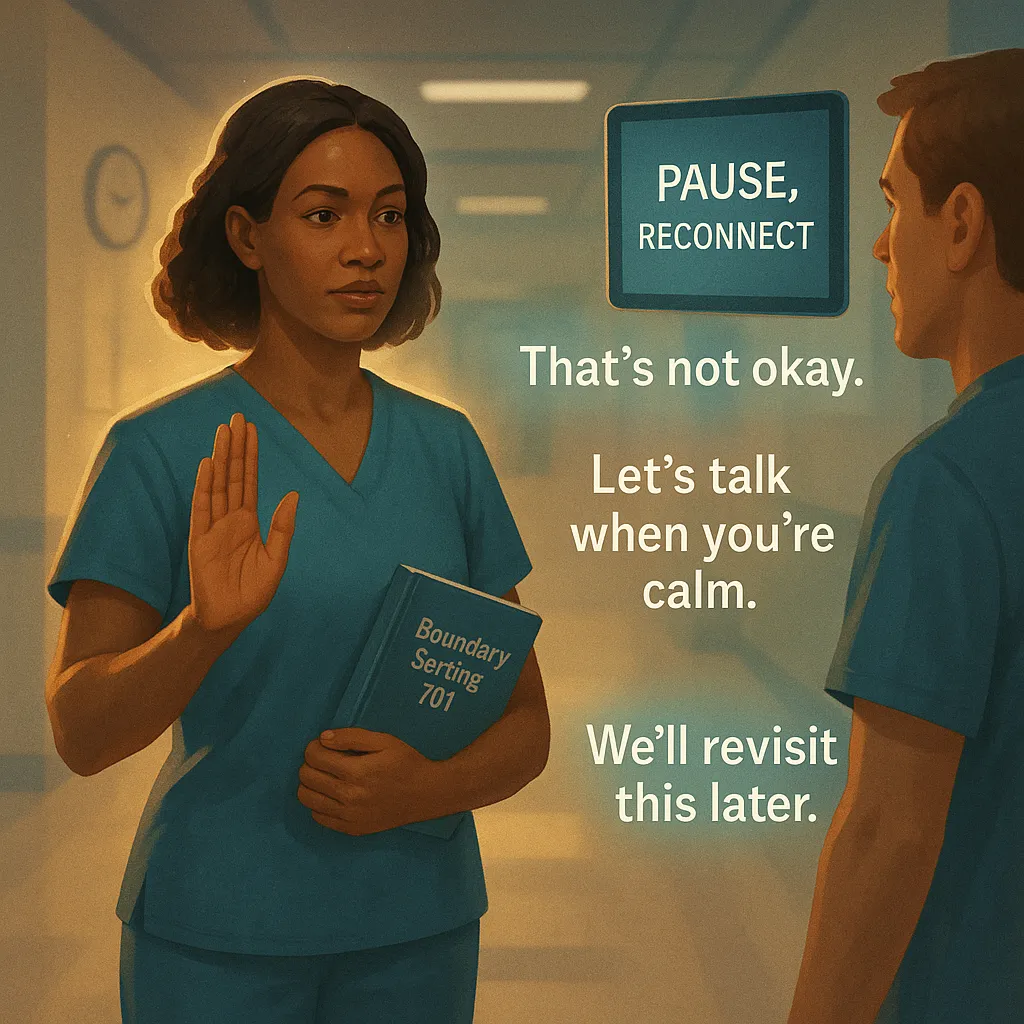How to Stop
Nurse-to-Nurse Bullying
A New Approach to Stop Nurse-to-Nurse Bullying
With up to 77% of nurses experiencing workplace bullying, immediate intervention is proving more effective than prevention alone. Learn how real-time responses disrupt this costly pattern ($56,300 per nurse turnover) and empower healthcare professionals to break the cycle.
Key Takeaways
Immediate response to nurse bullying works better than prevention alone, as it directly disrupts the pattern of behavior in real-time.
Up to 77% of nurses experience workplace bullying, with newly licensed nurses being particularly vulnerable to these behaviors.
The financial impact of nurse turnover related to bullying is substantial, costing hospitals an average of $56,300 per nurse and up to $9 million annually.
A multi-level approach combining individual, relationship, and organizational strategies creates the most effective defense against nurse-to-nurse bullying.
Learning specific in-the-moment response techniques can empower nurses to break the cycle of workplace bullying when it occurs.
Workplace bullying is an epidemic in healthcare settings, with studies showing between 25% and 77% of nurses experience some form of bullying during their careers. While healthcare organizations have invested heavily in prevention programs, these initiatives often fall short in addressing the immediate impact of bullying incidents as they occur. A growing body of evidence suggests that responding directly in the moment may be the most effective approach to stopping nurse-to-nurse bullying.
Healthcare professionals at EPIC Webinars have noted that immediate intervention is critical because it directly challenges bullying behavior when it's most impactful. When bullying goes unchallenged, it becomes normalized in the workplace culture, making prevention strategies less effective over time.
Why Immediate Response to Bullying Trumps Prevention
Traditional approaches to workplace bullying have focused primarily on prevention through policies, awareness training, and organizational culture initiatives. While these approaches are valuable, they often fail to address the critical moment when bullying actually occurs. Here's why immediate response is so powerful:

Disrupts the pattern: Addressing bullying behavior in real-time breaks the cycle and immediately challenges the bully's sense of power and control. This disruption is far more effective than policies that may never be enforced in practice.
Counters normalization: When bullying behaviors go unchallenged, they gradually become accepted as part of the workplace culture. Each silent witness unintentionally reinforces the behavior as acceptable.
Creates concrete consequences: Many bullies don't recognize their own behavior as problematic. Direct confrontation provides immediate, concrete feedback that's difficult to ignore or rationalize away.
Empowers witnesses: When someone responds effectively to bullying, it demonstrates to everyone present that such behavior isn't acceptable and provides a model for future responses.

A comprehensive study of newly licensed nurses found that those who confronted bullying directly experienced faster resolution of the problems and reported higher job satisfaction than those who relied solely on organizational reporting structures. This suggests that giving nurses the tools to respond in the moment may be more effective than administrative solutions alone.
The Hidden Cost of Nurse Bullying
Prevalence Across Healthcare Settings
Nurse-to-nurse bullying isn't an isolated issue but a systemic problem affecting healthcare institutions nationwide. Research consistently shows alarming rates of bullying within nursing, with studies indicating between 25% and 77% of nurses experience workplace bullying during their careers. What's particularly concerning is that newly licensed nurses face the highest risk, often becoming targets during their first year of practice when they're most vulnerable.
The forms of bullying vary widely, from subtle behaviors like withholding information and social isolation to more overt actions such as public criticism, intimidation, and even sabotage. In a survey of healthcare workers, common experiences included being assigned unreasonable workloads (62%), being ignored by colleagues (35%), having information withheld that was necessary for patient care (28%), and public humiliation (22%).
Financial Impact on Hospitals
The financial consequences of nurse bullying extend far beyond interpersonal conflicts, creating a substantial economic burden for healthcare organizations. When nurses leave their positions due to bullying, hospitals face significant replacement costs. Recent data shows:
The cost to replace a single registered nurse ranges from $37,000 to $67,100
The average replacement cost per RN is approximately $56,300
For a mid-sized hospital, annual turnover costs related to nurse replacement can reach $3.9 million to $9 million
These figures include direct expenses like recruitment, hiring, and training, but also indirect costs such as temporary staffing, overtime payments, reduced productivity during transition periods, and the impact on team cohesion and patient care quality.
Furthermore, the financial toll is only part of the equation. Nurse bullying also correlates with increased medication errors, higher rates of patient complaints, reduced quality indicators, and increased absenteeism. Organizations that fail to address bullying effectively essentially pay twice: once for the operational inefficiencies created by a toxic work environment, and again for the high costs of turnover when nurses inevitably leave.
Individual-Level Strategies to Combat Nurse Bullying
Building Confidence in Your Nursing Skills
One of the most effective shields against workplace bullying is professional competence and self-confidence. Newly licensed nurses who continuously develop their skills and knowledge create a foundation of professional security that makes them less vulnerable to intimidation tactics. Consider these approaches:
Ongoing education: Regularly participate in continuing education to strengthen clinical knowledge and keep skills current.
Skill documentation: Maintain a personal portfolio documenting your competencies, certifications, and positive feedback from patients and colleagues.
Performance metrics: Track your own performance indicators to provide objective evidence of your capabilities.
Seek feedback proactively: Rather than waiting for criticism, actively request constructive feedback from trusted mentors and use it to improve.
Nurses who responded to surveys about bullying prevention consistently mentioned that feeling secure in their professional abilities gave them the confidence to stand up to bullying behaviors when they occurred.
Understanding Your Professional Boundaries
Clarity about your scope of practice, job description, and professional boundaries provides another layer of protection against bullying behaviors. When you thoroughly understand your role and responsibilities, you can respond confidently when faced with inappropriate demands or criticism. This includes:
Role clarity: Review your formal job description and understand exactly what falls within your scope of practice and what doesn't.
Recognize overreach: Learn to identify when requests or criticism extend beyond reasonable professional expectations.
Know your rights: Familiarize yourself with your organization's policies regarding workplace conduct and protection from retaliation.
Set healthy boundaries: Practice clearly communicating your professional limits in a firm but respectful manner.
One nurse described successfully stopping bullying by stating: "I intervened by standing up for myself. I told the bully that I know my job description, and I'm not going to do your job and mine too." This clear boundary-setting effectively halted the inappropriate behavior.
Relationship-Based Approaches to Stop Bullying
1. Directly Addressing the Bully
While many nurses avoid confrontation, evidence shows that addressing bullying behavior directly is one of the most effective immediate interventions. When done professionally and assertively, direct confrontation can stop the behavior and establish clear boundaries. The approach should be strategic:
Choose the right moment: Address the behavior promptly, but privately – not in front of patients or other staff.
Use specific examples: Clearly identify the problematic behavior rather than making general accusations.
Focus on impact: Explain how the behavior affects you, your work, and potentially patient care.
State your expectation: Clearly articulate what professional behavior you expect going forward.
One nurse described successful intervention: "I stopped report and stated 'I don't know what your deal is or what you are trying to accomplish by interrupting and making gestures. I am new to your unit and did the best I could with resources available. I will appreciate you not constantly interrupting and making gestures.'" This direct approach quickly resolved the situation.
2. Using De-escalation Techniques
De-escalation techniques can be powerful tools when confronted with bullying behavior. These approaches help prevent the situation from intensifying while maintaining your professional composure:
Remain calm: Controlling your emotional response prevents the situation from escalating.
Use neutral language: Avoid accusatory statements that could trigger defensiveness.
Acknowledge perspective: Statements like "I understand this is a stressful situation" can diffuse tension.
Refocus on shared goals: Remind everyone that patient care is the priority.
A newly licensed nurse reported using this approach: "I said thank you to both the nurses several times and stated that the incident helped my learning." Another nurse defused a situation by saying, "I asked her how much experience she had in this position and when she said she had less than a year, I told her that we were both learning then because nursing requires lifelong learning."
3. Fostering Supportive Peer Networks
Building strong relationships with colleagues creates a support system that can both prevent bullying and provide assistance when it occurs. Supportive networks serve multiple functions:

Safety in numbers: Bullies are less likely to target someone with strong peer connections.
Emotional support: Peers can validate experiences and provide perspective when bullying occurs.
Practical assistance: Colleagues can step in during difficult situations or serve as witnesses.
Professional growth: Peer relationships facilitate knowledge sharing and skill development.
Nurses who develop strong professional relationships with colleagues report feeling more confident in addressing workplace challenges, including bullying situations.
4. Encouraging Upstanding Behavior
"Upstanding" refers to the active intervention by witnesses when bullying occurs. Unlike bystanders who observe but don't act, upstanders take positive action to stop bullying behavior. This approach recognizes that addressing bullying is a collective responsibility:
Intervention strategies: Train all staff in techniques to safely interrupt bullying behavior.
Support the target: Simply standing beside the person being bullied can diminish the bully's power.
Redirect conversations: Change the subject or invite others into the conversation to disrupt the bullying dynamic.
Report the behavior: Support colleagues in documenting and reporting incidents through proper channels.
One nurse described witnessing effective upstanding: "The nurse educator stepped in to help out, because she knows I was a new nurse and felt very overwhelmed at the moment." Another reported: "The nurse preceptor pointed out to the [bully] that it wasn't okay to say that and that I was in training."

Organizational Solutions for Systemic Change
Creating a Team-Oriented Culture
Addressing nurse bullying requires more than individual interventions—it demands systemic cultural change within healthcare organizations. A team-oriented work environment forms the foundation for preventing and addressing bullying behavior:
Shared goals and values: Clearly articulate that collaboration and respect are core organizational values.
Team-building activities: Regular opportunities for staff to build relationships outside of stressful work situations.
Interdisciplinary collaboration: Structured approaches to care that emphasize input from all team members.
Recognition systems: Reward collaborative behavior and exemplary teamwork rather than only individual achievement.
As one nurse observed, "When behavior like that [bullying] occurs, peers that have been working on that unit for some time need to remind each other of the importance of team work and how that reflects on patient safety."
Implementing Effective Reporting Systems
For organizational approaches to succeed, healthcare institutions must create reporting systems that nurses trust and will actually use:
Clear procedures: Simple, accessible processes for reporting bullying incidents.
Multiple channels: Options for reporting that don't require going through the chain of command if a supervisor is involved.
Confidentiality protections: Safeguards to prevent retaliation against those who report bullying.
Transparent follow-up: Clear communication about how reports are handled and what actions are taken.
One successful intervention was described as: "After the incident we wrote a safety report and the charge nurse called the bully's supervisor directly." Another example showed the importance of accountability: "The head of HR and the head of the department intervened. The manager was investigated and fired."
Developing Mentorship Programs
Mentorship programs provide structured support specifically for new nurses, who are most vulnerable to bullying:
Formal matching: Pair new nurses with experienced mentors outside their direct reporting line.
Protected time: Dedicated hours for mentorship activities separate from clinical responsibilities.
Skills development: Focus on both clinical skills and workplace navigation, including how to handle difficult interpersonal situations.
Long-term relationships: Extend mentorship beyond the typical orientation period to provide ongoing support.
One participant in a study noted the importance of mentorship: "Have the preceptor already informed of what the nurse's experience is before they begin working together so it is not a surprise."
From Silence to Action: A Call for Nurse Empowerment
Breaking the cycle of nurse-to-nurse bullying requires a fundamental shift from a culture of silence to one of action and empowerment. This transformation depends on several key elements:
Recognize the problem: Acknowledge that bullying is not just "part of nursing culture" or something to be endured as a rite of passage.
Reframe intervention as professional responsibility: View addressing bullying as an essential part of nursing professionalism and patient advocacy.
Develop concrete skills: Learn and practice specific techniques for responding to bullying behavior in the moment.
Create collective accountability: Build a professional culture where everyone takes responsibility for maintaining a respectful workplace.
The journey from silence to action isn't easy, but it's necessary for the future of nursing. By equipping nurses with the tools to respond effectively to bullying when it occurs, rather than just trying to prevent it through policies alone, we can create healthier work environments that support both nurse wellbeing and optimal patient care.
When nurses stand up against workplace bullying—both for themselves and their colleagues—they reclaim their professional dignity and help create the supportive, collaborative environments that allow all healthcare providers to thrive.
We have a free workshop called The Good Nurse Syndrome to introduce some techniques you can use right away on your unit. And then you can always check out the multi-module workshops that go into much greater detail and include workbooks, bonuses, and XP points (a way to earn additional surprise bonuses).
Alison
As a retired Director of Nursing with decades of leadership experience, I’ve seen the full cycle of lateral violence play out — not just at the bedside, but at the organizational level. I’ve been the target of it, I’ve inadvertently contributed to it, and I’ve spent years trying to fix it from both sides of the table.
That’s why I created Breaking the Silence. Not as another compliance training — but as a strategic, real-world solution designed by someone who understands what’s at stake for both your staff and your institution.
I’ve spent years researching, practicing, and refining the exact communication, negotiation, and leadership tools that
empower nurses to end these toxic patterns at the source — without adding to your HR workload.
This workshop series is built for the realities of healthcare leadership today: Flexible. Practical. Proven to work.
Because I’ve been where you are — and I know what it takes to finally shift the culture for good.

Let's Hear What Real People Have to Say
"Found your webinar very engaging!
It (obviously) exposes the power dynamics which nursing staff, specifically, are subjected to but I think it extends beyond that too, to power structures in all organisations. In fact it increased my awareness and approach to a problem
I am currently witnessing at work.
I like your straight to the point style. Your authority in the area comes across!"

Fiona P.
Clinical Psychologist
"Your excellent work is most noteworthy. I'm most impressed with your analytical/conceptual abilities. You are most capable of integrating complex theoretical materials and relating those to the issues at hand.
Your communication skill is highly regarded!"

Dick C.
EdD
"What can I say - Excellent!"
Marie
EdD

"One cannot place an economic value on professional growth and development. Congratulations on a truly superior product. You have an excellent communication style."

Kim D.
DEd

Your EPIC Choice for Emotional Growth
At Work, At Home, At Play

Navigation
EPIC Webinars Home
EPIC Webinar Experts
Our EPIC Webinars
Blog - The EPIC Audience
Work Hours
9AM - 5 PM PST, Monday - Friday
Our Support and Sales team is available during regular business hours to answer your queries
© 2025 Epic Webinars . All rights reserved




